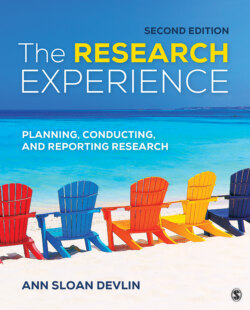Читать книгу The Research Experience - Ann Sloan Devlin - Страница 125
Revisit and Respond 3.1
ОглавлениеExplain how a quasi-IV differs from an IV and the difference in language appropriate to use in a correlational versus an experimental study.
Identify the IV (manipulated variable) and the DV (effect or outcome variable) in the following description:
“The campers were randomly assigned to two different cabins right next to each other, A and B; the camp director wanted to test the effectiveness of different kinds of mosquito netting (MN) and placed MN with white nylon fabric in Cabin A and MN with black nylon fabric in Cabin B. There was a significant difference in the number of bug bites reported by the campers in the two different cabins.”
As discussed earlier, if you ask a question about the sample as a whole without any manipulation that forms groups, you will have a correlational research design. For example, if you ask whether the number of magazine subscriptions in a home is related to reading scores in fourth graders (see Figure 3.2), you will have a correlational design; the statistics will be Pearson’s r.
Description
Figure 3.2 Example of Correlational Research Design
Figure 3.3 Example of Quasi-Experimental Research Design
Source: Adapted from Devlin, A. (2006), Research methods: Planning, conducting, and presenting research. Belmont, CA.: Wadsworth/Thomson., Figure 2.2.
If you ask a question about group differences, and the groups preexist (like subscribing to print magazines or not), you will have a quasi-experimental design. For example, if you ask whether there are higher fourth-grade reading scores in the homes of people who subscribe to print magazines than in the homes of people who do not, that is a quasi-experimental design (the preexisting groups are composed of people with and without print magazine subscriptions; see Figure 3.3). In that particular situation, if your quasi-independent variable is print magazine subscriptions, which has two levels (yes or no) and your dependent variable is the fourth-grade reading scores of the children from those homes (one DV), your statistical analysis will be an independent samples t test. There is still no causality.
If you ask a research question about group differences, and the groups are created through manipulation, you will have an experimental research design. For example, if you create written scenarios (written text describing situations) in which participants are randomly assigned to read a scenario about a home with no (zero) magazine subscriptions/month versus a home with 10 magazine subscriptions/month, and you ask participants their estimate of the reading scores of the fourth graders in the home (chosen from a scale of the possible reading scores), that is an experimental design (see Figure 3.4). In this situation, there is one IV (magazine subscriptions) with two levels (zero vs. 10 subscriptions/month) and one DV (the reading score estimate). Again, your statistical analysis will be an independent samples t test.
The statistical test in the examples of the quasi-experimental and true experimental designs are the same, but the language you use to describe the results will differ. In the case of the quasi-experimental research, you will use the language of correlation—for example, probably that subscribing to print magazines is associated with having higher fourth-grade reading scores than is the case in a home where there are no print magazine subscriptions. With this experimental design, you have the language of causality, for example, that reading about a household with 10 magazine subscriptions/month led to judgments of higher reading scores in fourth graders than did reading about a household with no (zero) magazine subscriptions/month.
Figure 3.4 Example of Experimental Research Design
Source: Adapted from Devlin, A. (2006), Research methods: Planning, conducting, and presenting research. Belmont, CA.: Wadsworth/Thomson., Figure 2.3.
Appendix A (Figure A.1) at the end of the book contains a statistical decision tree that you may find helpful when thinking about how to evaluate your research question statistically.
